As it is known, water covers at least 70% of the earth’s surface, meaning there is more water than we can even imagine. However, most of these waters are still unexplored, and experts are not entirely sure what could be in them or if they are safe for humans.
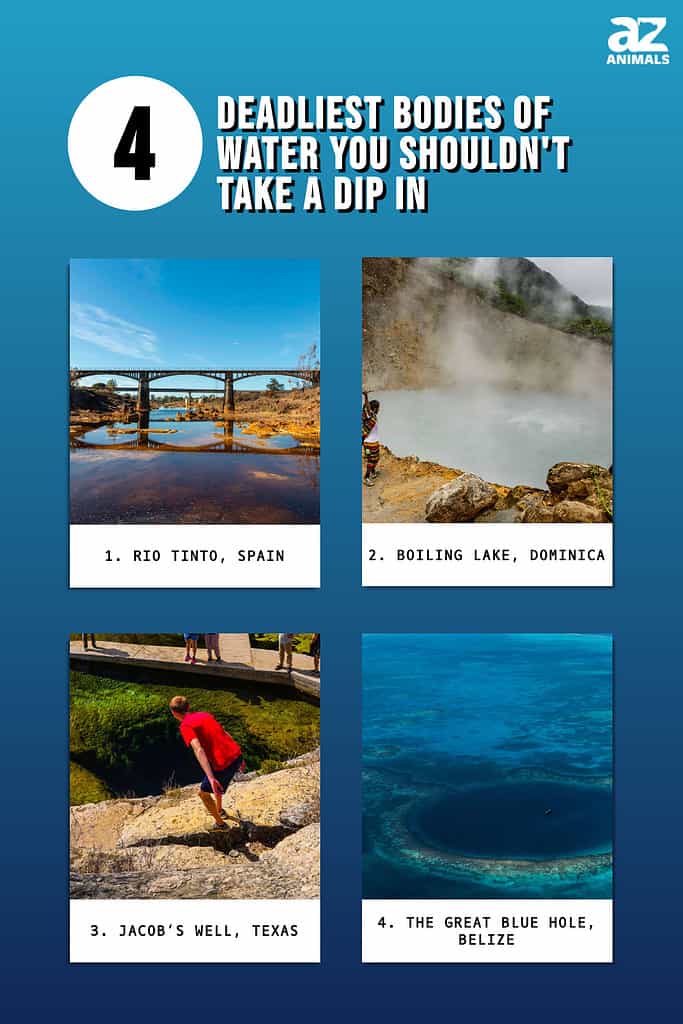
Some of these bodies of water have been studied but have been declared too dangerous for humans to enter or be around. In other words, there are bodies of water in different parts of the world that are unsafe for humans for several reasons. What do you think these bodies of water are, and why do you think they are considered deadly? This article discusses some of these deadly waters in no particular order.
1. Rio Tinto, Spain
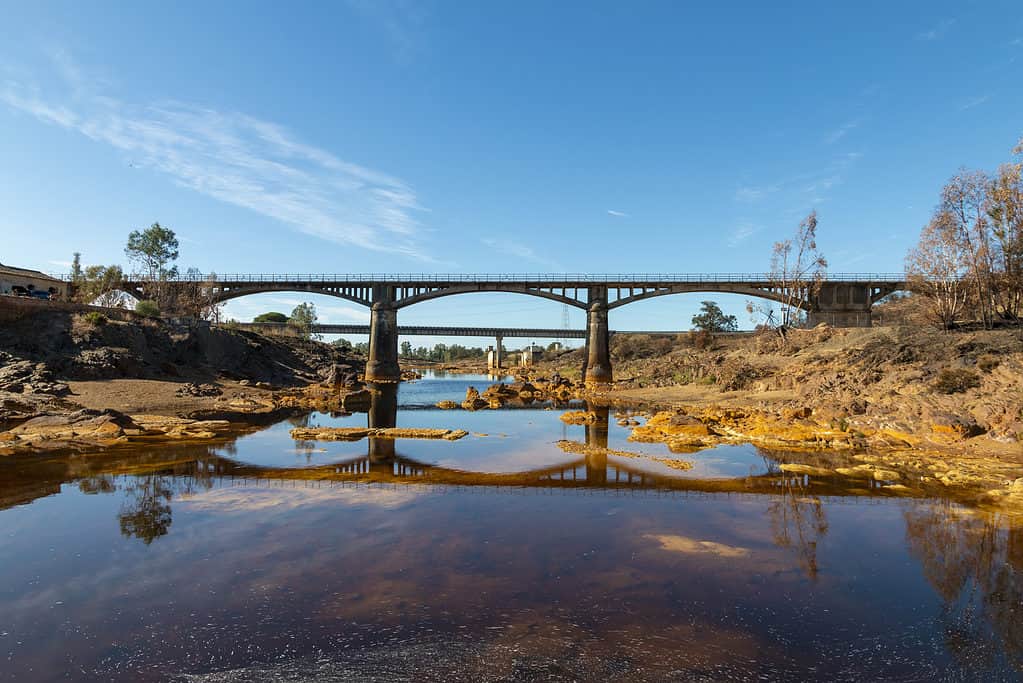
The red color of the Rio Tinto is not natural. It is due to over 5,000 years of ore mining pollution.
©iStock.com/juanorihuela
The Rio Tinto, or Red River or Tinto River, is located in southwestern Spain. As it is fondly called, the Red River is unlike any river anywhere else in the world, with its unusual red color. However, unlike what most people believe, the red color of the river is not natural. Regardless of how pretty this river looks because of its unique color, it has been declared unsafe for humans for a number of reasons. The primary reason for the river’s color and its danger to humans is the mining activity around the river.

Contamination occurs when chemical compounds leach into the water and surrounding areas.
©blackboard1965/Shutterstock.com
The river’s red color is due to over 5,000 years of ore mining pollution. The river contains a lot of heavy metals like copper and iron that have accumulated over the years. These irons dissolve into the water, giving it its unique color and making it impossible for humans and even other aquatic animals to survive in it. The river’s environment is harsh, fostering the growth of organisms like iron and sulfur-oxidizing bacteria as well as other microbes that scientists have linked with microbe samples from other planets like Jupiter’s moon. Although the waters are not fit for humans to swim in, it still attracts many scientists.
2. Boiling Lake, Dominica

The Boiling Lake is located within the vicinity of a volcano.
©iStock.com/pabst_ell
Of all the natural wonders of the world, hot springs are people’s favorite, especially on cold winter days. Many consider these hot springs as natural hot tubs, and they are not wrong. Nevertheless, some hot springs in the world are too hot to handle, and the boiling lake in Dominica (an island in the Caribbean) is one of them. This boiling lake is a flooded vent on the surface of the earth in Morne Trois Pitons National Park. The primary reason this hot spring is unlike any other in the world, despite being the second largest ever, is that the temperatures are too high for humans to swim in it.
The water at the edge is as hot as 180 to 197 degrees, which is already too hot to relax in. How hot is the water at the center? Unfortunately, the water at the center of the hot spring cannot be measured due to the amount of steam in the area. Although the hot spring witnesses a drop in its temperature enough for humans to swim in it, it is still dangerous as it releases harmful gases and steam explosions from time to time. The primary reason for the excessive gases and the occasional steam explosion is the location of the hot spring. The hot spring is located within the vicinity of a volcano.
No one is aware of the process or what takes place when the hot spring undergoes all these changes, despite the fact that the Boiling Lake has gone through several phases of chilling, drying out, and boiling up again throughout history.
3. Jacob’s Well, Texas

Jacob’s well is the second-largest fully submerged cave in the state of Texas.
©Christian Perry/Shutterstock.com
Another one of the most dangerous bodies of water in the world is Jacob’s Well in Wimberley, Texas. This site is a popular tourist attraction, particularly in the summer, because of its pretty clear water. The water may appear appealing and clear, but it is actually quite dangerous. Although referred to as a well, it is actually a perennial karstic spring and the second-largest fully submerged cave in the state of Texas. The Trinity Aquifer, which almost completely covers the state’s southwest, is where the water in Jacob’s Well comes from.
Despite looking like an inviting dive, the problem with diving inside the “well” is its narrow pathways. These passageways become so narrow that divers have to take off their masks, giving them limited time to stay submerged. Because of the lack of air and the sheer depth of this cave, it is almost impossible to dive to the bottom and make it out alive. There have been many deaths over the years, and the ones who somehow survive describe it as a terrifyingly near-death experience.
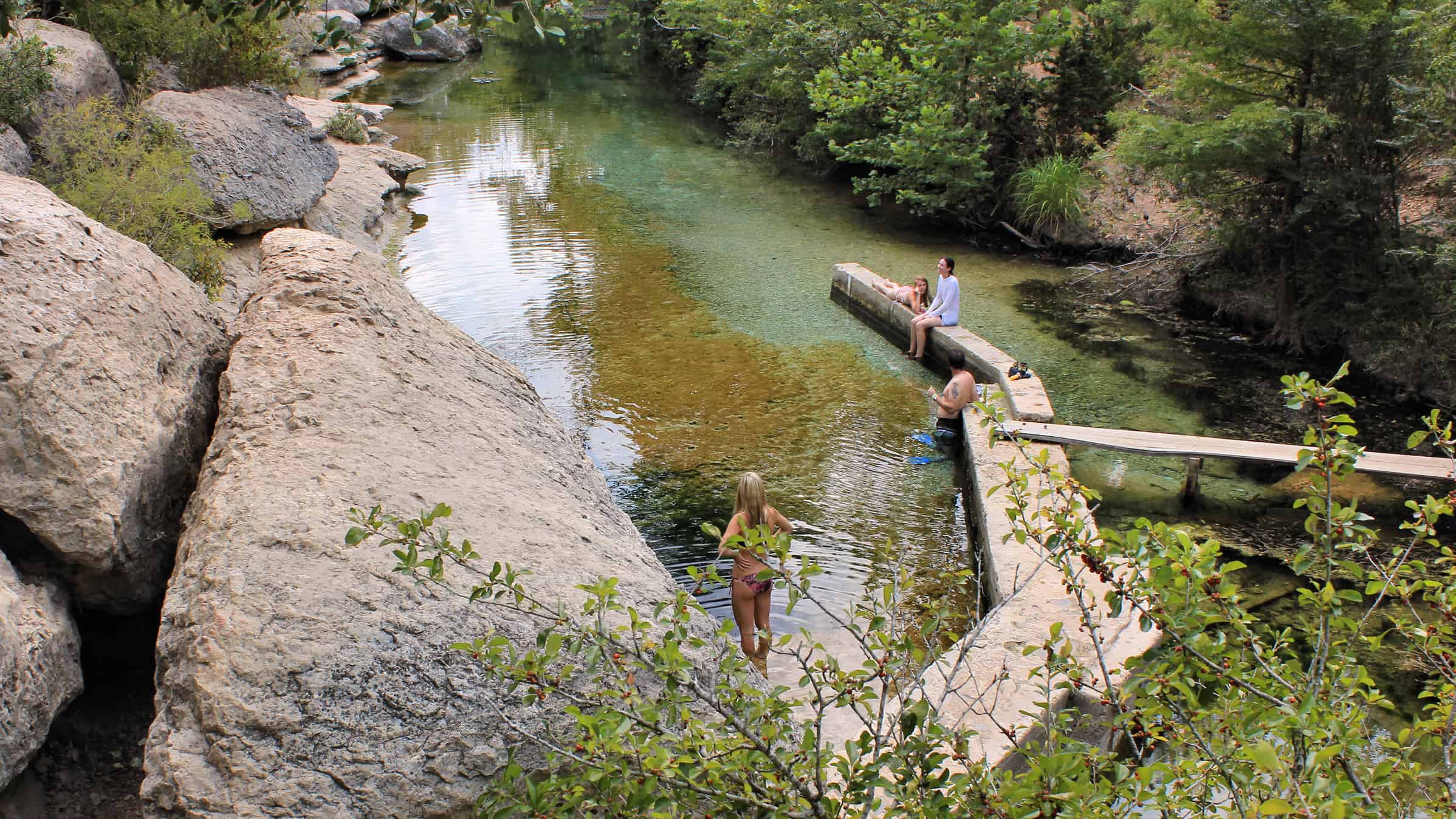
Jacob’s well is a swimming hole in Texas.
©Larry D. Moore/CCBYSA4.0 – License
Also, the opening of the well is only about 12 to 13 feet, meaning that even daredevil divers who want to explore inside cannot dive in straight from the top because there is a high chance they bash their bodies against the many huge rocks that surround the opening. This hasn’t stopped many from diving head-first into it, though.
4. The Great Blue Hole, Belize
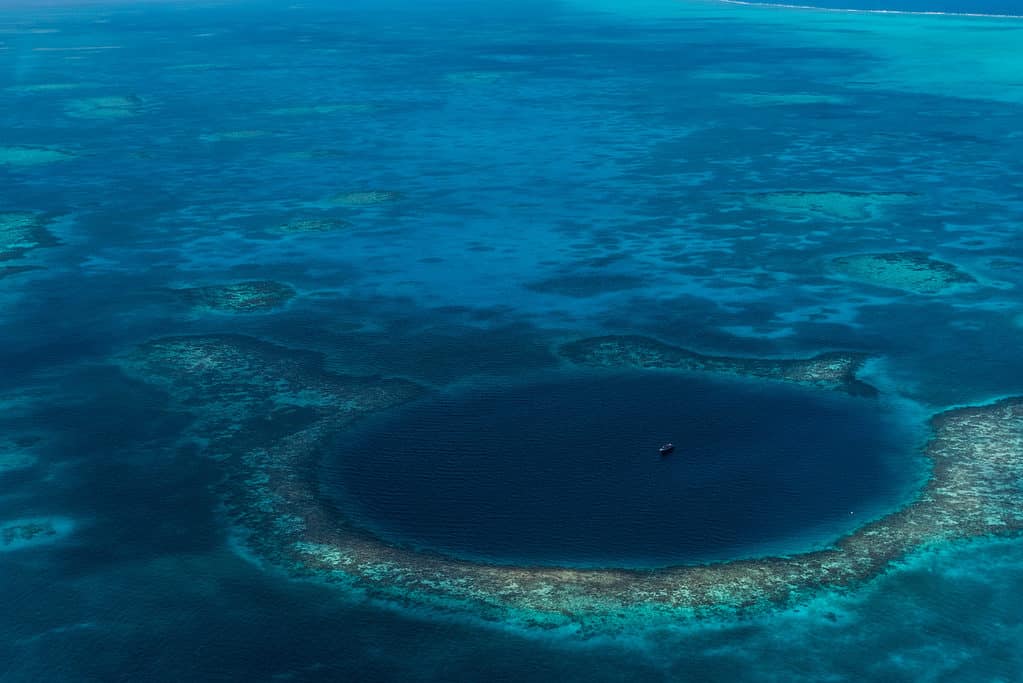
The great blue hole is the world’s deepest underwater sinkhole, measuring 984 feet wide and 410 feet deep.
©iStock.com/hartmanc10
Off the coast of Belize, there is a sizable marine sinkhole called The Great Blue Hole. The United Nations Educational, Scientific, and Cultural Organization (UNESCO) has designated it as a World Heritage Site and is considered one of the best diving locations on earth. Its popularity has been attributed to its beautiful waters, breathtaking vastness and majesty, and its amazing variety of marine life. This blue hole is the world’s deepest underwater sinkhole, measuring 984 feet wide and 410 feet deep.
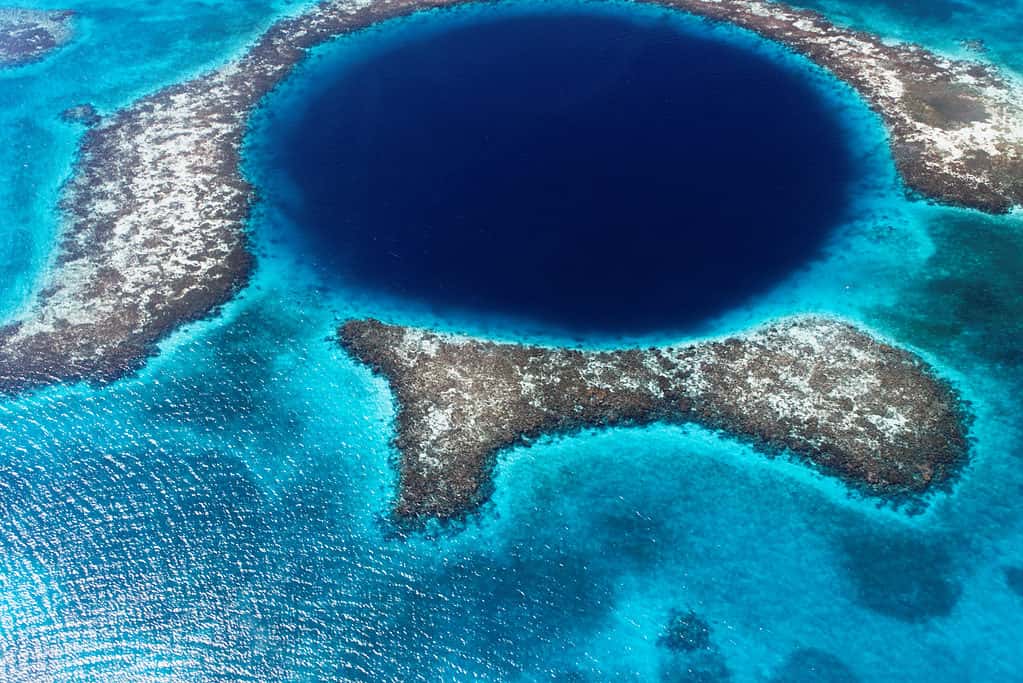
It is difficult to gauge depth since the Great Blue Hole’s water is so clear.
©iStock.com/Lomingen
Despite its beauty, the blue hole is still very dangerous, particularly for inexperienced divers. The primary reason this site is considered dangerous is because of its depth, as even professional divers cannot reach the bottom of the hole. It is more difficult to gauge distances since the Great Blue Hole’s water is so clear. In other words, it is almost impossible to know how deep in the hole you are because the water’s clarity shortens the distance in your mind. Trying to swim while thinking you can cover a good distance in a short while is dangerous, and the water pressure that far below the surface can cause nitrogen narcosis and could easily kill anyone.
Summary of Four Deadliest Bodies of Water
Think twice before you dive into these waters!
| Body of Water and Location | |
|---|---|
| 1 | Rio Tinto, Spain |
| 2 | Boiling Lake, Dominica |
| 3 | Jacob’s Well, Texas |
| 4 | The Great Blue Hole, Belize |
Other Dangerous Bodies of Water Worth a Mention:
- Lake Kivu is on the border of Rwanda and the Democratic Republic of the Congo. This is a freshwater lake, but it has large amounts of methane gas at the bottom. An earthquake or volcanic eruption could cause a massive explosion. Further, this lake has high levels of microbial contamination.
- Frying Pan Lake, the world’s largest hot spring, is a crater in the Waimangu Volcanic Rift Valley in New Zealand. It has high acidity, sulfur-oxidizing bacteria, and water as hot as 122 degrees Fahrenheit. These waters can suddenly erupt, scalding anyone in range.
- Lake Karachay, in the Southern Ural Mountains in Russia, is extremely dangerous because of high radioactivity. It was used as a dumping ground for a nearby nuclear waste facility and is now twelve times more toxic than the Fukushima disaster area.
- Lake Natron in Tanzania is highly alkaline (up to pH 10.5). It is fed by mineral-rich hot springs, but there is no outlet. Thus, evaporation leaves behind minerals, with large concentrations of sodium chloride and cyanobacteria. Fortunately, flamingoes feed on and get their pink color from cyanobacteria, so Lake Natron is a Lesser Flamingo breeding site.
The photo featured at the top of this post is © iStock.com/Lomingen
Sources
- , Available here: https://blog.therainforestsite.greatergood.com/most-dangerous-waters/
- Jaime Trosper, Available here: https://interestingengineering.com/science/10-of-most-dangerous-water-bodies
- , Available here: https://www.businessinsider.com/dangerous-bodies-of-water-on-earth-2015-5
Thank you for reading! Have some feedback for us? Contact the AZ Animals editorial team.






